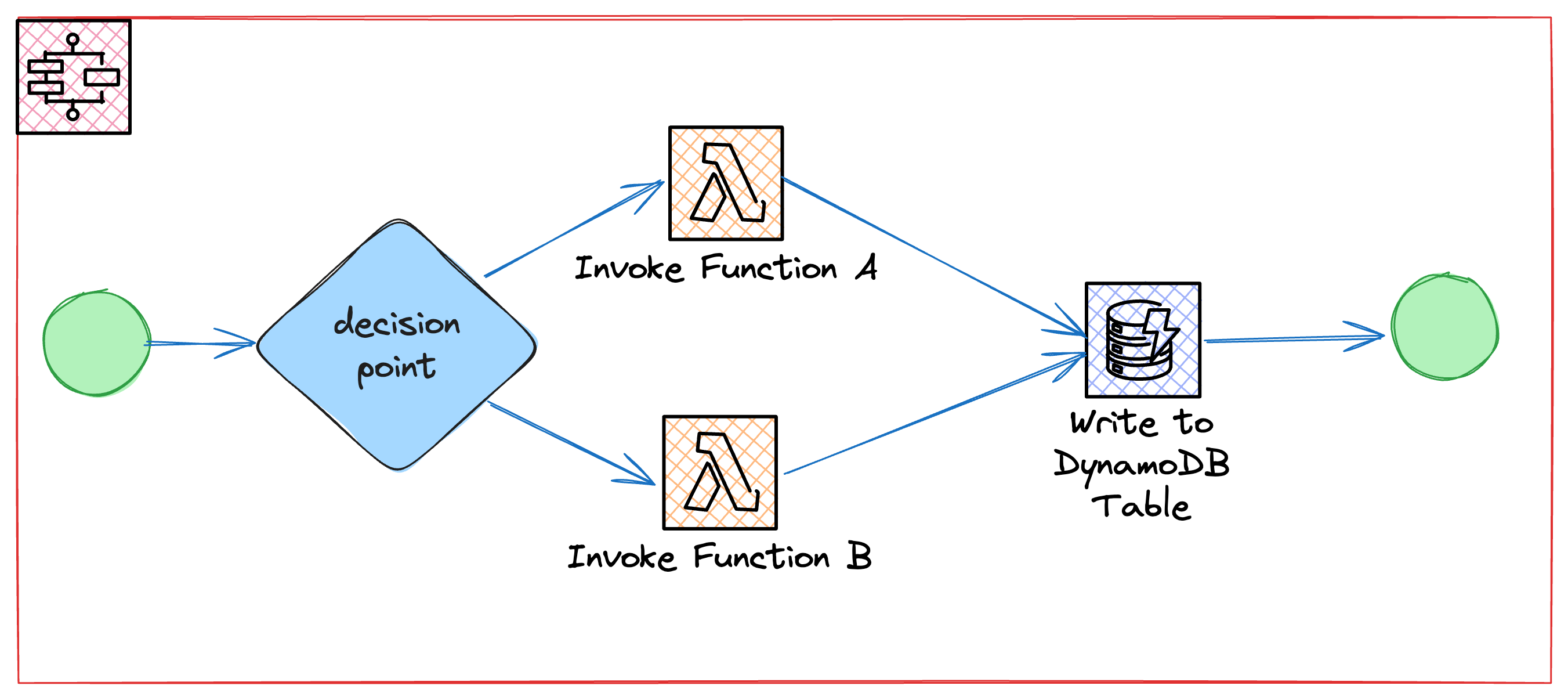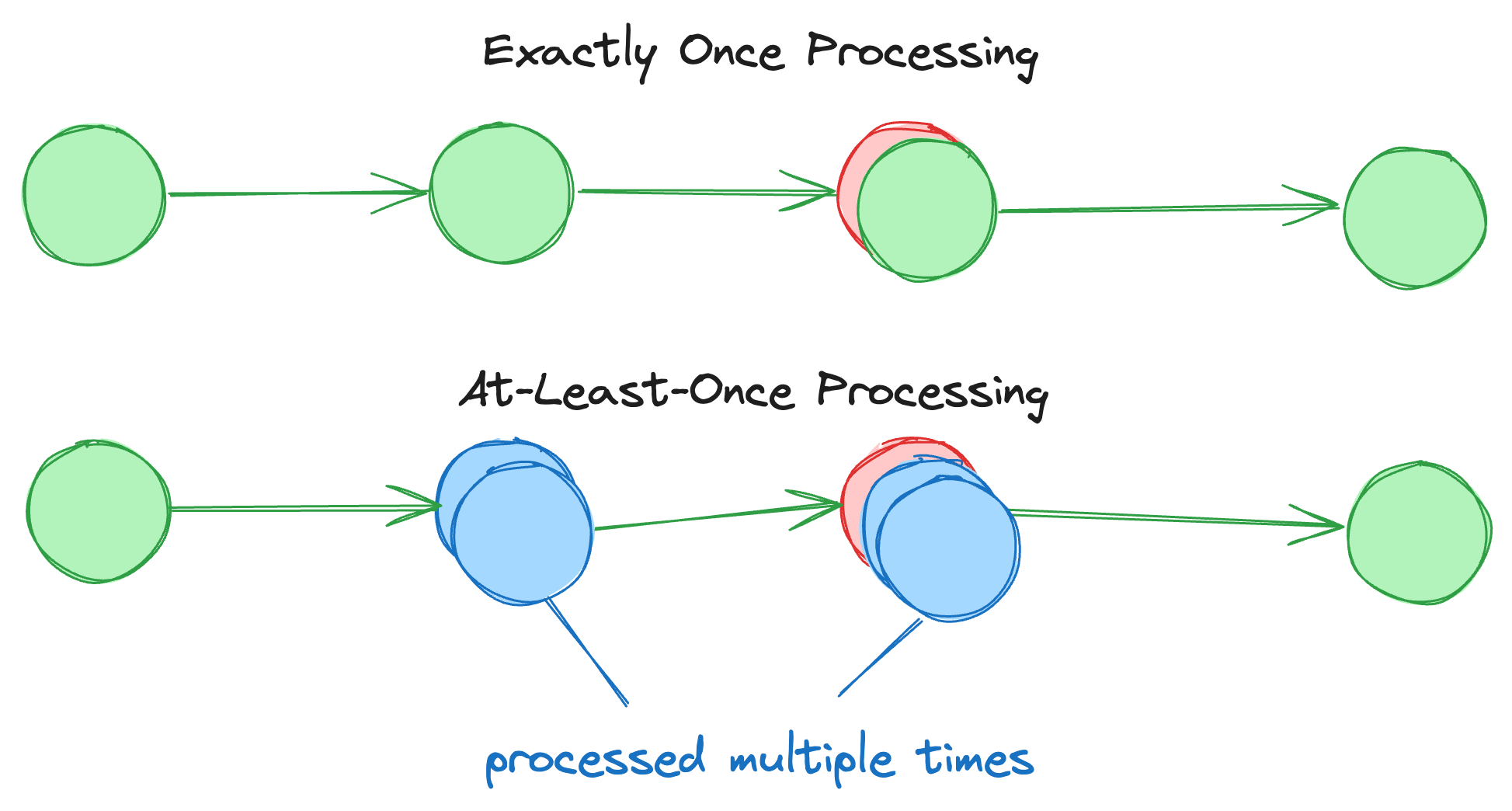AWS Step Functions: Standard vs. Express Explained
 Tobias Schmidt
Tobias Schmidt
AWS Step Functions is an amazing orchestration service that enables you to design and manage complex workflows by coordinating various AWS services. It simplifies building and running multi-step applications and ensures that each step happens in the right order and errors are handled gracefully.
In this post, we'll dive into the world of Express and Standard Step Functions, the two types of workflows offered by AWS Step Functions.
We'll break down their differences, explore when to use each one, and discuss the benefits of both, helping you pick the right one for your needs.

For seeing the performance differences, we’ve prepared a very simple application that you can run in and deploy to your own AWS account.
Comparison Overview
Before we jump into the specifics, here’s a comparison summary about the limitations:
| Type / Category | Standard Workflows | Express Workflows |
| ⏳ Maximum duration | One year | Five minutes |
| 🏁 Execution start rate | See API action throttling quotas As of 09/2024: Bucket Size is 800-1300 & Refill Rate 150-300/s | See API action throttling quotas As of 09/2024: Bucket Size is 6000 & Refill Rate 6000/s |
| ⚡️ State transition rate | See state throttling quotas As of 09/2024: Bucket Size is 800-5000 & Refill Rate 800-5000/s | No limit |
| 💸 Pricing | By state transitions | By executions, duration, and memory |
| 📚 Execution history | Listed, described, and debugged via APIs, console, and CloudWatch Logs | Unlimited within 5 minutes, debugged via console and CloudWatch Logs |
| Execution semantics | Exactly-once | Async: At-least-once, Sync: At-most-once |
| Service integrations | All integrations and patterns supported | All integrations, no Job-run (.sync) or Callback (.waitForTaskToken) |
| Distributed Map | Supported | Not supported |
| Activities | Supported | Not supported |
Overview of AWS Step Functions
AWS Step Functions is a fully managed service that enables developers to coordinate multiple AWS services into serverless workflows. It simplifies the process of building and running multi-step applications by providing a visual interface to design and manage workflows.

The primary purpose of AWS Step Functions is to help developers orchestrate complex workflows by defining the sequence of steps required to execute a task.
It ensures that each step is executed in the correct order, handles errors gracefully, and manages the state of the workflow throughout its execution.
Key Features and Benefits
Before we dive into the specifics of the two types of step function state machines, let's take a look at their general key features and benefits:
Visual Workflow Design: AWS Step Functions offers a graphical interface to design workflows, making it easier to visualize the sequence of steps and their dependencies.
State Management: It automatically manages the state of each step in the workflow, ensuring that the application can resume from the last successful state in case of a failure.
Error Handling: Built-in error handling capabilities allow developers to define retry policies and fallback mechanisms, improving the reliability of workflows.
Integration with AWS Services: Step Functions seamlessly integrates with a wide range of AWS services, such as AWS Lambda, Amazon S3, Amazon DynamoDB, and more, enabling the creation of complex, serverless applications.
Scalability: The service is designed to scale automatically, handling thousands of parallel executions without requiring manual intervention.
Cost Efficiency: With pay-as-you-go pricing, users only pay for the number of state transitions required to execute their workflows, making it a cost-effective solution for orchestrating tasks.
Audit and Monitoring: Step Functions provides detailed execution history and logs, allowing developers to monitor and audit the performance of their workflows.
Flexibility: It supports both Standard and Express workflows, catering to different use cases ranging from long-running, durable workflows to high-volume, short-duration tasks.
Standard Step Functions
The Standard Workflows are designed for applications that require long-running, durable, and auditable state management.
Standard Step Functions guarantee exactly once processing, ensuring that each step in your workflow is executed precisely one time, even in the face of retries or failures.

This is particularly important for applications where data consistency and reliability are critical. For example, consider a financial transaction processing system where each transaction must be processed exactly once.
Moreover, Standard Step Functions are perfect for long-running processes that may span hours, days, or even months (effectively up to one year - if it’s longer, the execution will time out). These workflows are designed to handle complex state management and can seamlessly coordinate multiple services and tasks.

For instance, in a supply chain management system, Standard Step Functions can track the progress of an order from the initial request through various stages such as inventory check, payment processing, packaging, and shipping.
Additionally, Standard Step Functions are considered durable due to their ability to maintain state (which will be stored internally in the Step Function service) and recover from failures.

This durability ensures that even if a step in the workflow fails or the system experiences an outage, the workflow can resume from the last successful state without losing any progress. You can also inspect the stored state of every step in the AWS console to current state of the application of that time. This is crucial for applications that require high reliability and fault tolerance.
Lastly, Standard Step Functions are auditable, which means that every step in the workflow is logged and can be reviewed later. This is particularly important for compliance and debugging purposes. You can easily trace the execution path of a workflow, inspect the input and output of each step, and identify where any issues occurred - everything directly in the console.

This level of transparency is important for maintaining the integrity of your processes. Additionally, the audit logs can be used to generate detailed reports which can be then for example used to get insights into the performance the workflows.
Express Step Functions
Express Workflows are designed for high-volume, short-duration, and cost-sensitive applications that require fast state management.
Express Step Functions are optimized for high-throughput and low-latency processing, making them ideal for applications where speed and cost-efficiency are important.

Unlike Standard Step Functions, Express Workflows do not guarantee exactly once processing but instead offer at-least-once processing, which is suitable for scenarios where occasional duplicate executions are acceptable.
Express Step Functions are perfect for short-lived processes that typically complete within minutes. The maximum duration of the workflow can’t exceed 5 minutes. These workflows are designed to handle high-frequency event processing. For instance, in a real-time data processing system, Express Step Functions can process incoming data streams, perform transformations, and store the results in near real-time.
Additionally, Express Step Functions are highly scalable and can handle thousands of executions per second. This scalability ensures that your application can handle sudden spikes in traffic without compromising performance.
Express Step Functions are also cost-effective, as you are billed based on the number of requests and the duration of each execution. This makes them an great choice for applications with unpredictable or bursty workloads.
While Express Step Functions do not offer the same level of durability as Standard Step Functions, they still provide basic error handling and retry mechanisms. This ensures that your workflows can handle transient failures and continue processing.
Express Step Functions are also auditable, but with a focus on performance and cost-efficiency. Execution history is retained for a limited time, allowing you to review recent executions and troubleshoot issues. However, the level of detail and retention period is less than that of Standard Step Functions.
Also, the execution details are retrieved from and rendered via data from CloudWatch. This means, after the execution has finished, it can take some time to visualized in the console UI.
Detailed Comparison: Express vs. Standard
Let’s have a look at the detailed comparison of both workflow types.
Performance and Scalability
Execution speed
Express Workflows are designed for high-throughput, short-duration tasks and can start almost instantly, making them ideal for real-time processing. Standard Workflows, while slightly slower to start, are optimized for long-running, durable tasks.
Concurrency limits
Express Workflows can handle up to 100,000 executions per second, making them highly scalable for massive workloads. Standard Workflows have a lower concurrency limit, typically around 2,000 executions per second, but offer better durability for each execution.
Cost
Pricing Model
Express Workflows are billed based on the number of requests and the duration of execution, making them cost-effective for high-frequency, short-duration tasks. Standard Workflows are billed based on the number of state transitions, which can be more economical for long-running workflows with fewer transitions.
Cost Efficiency in Different Scenarios
Express Workflows are more cost-efficient for high-volume, short-duration tasks due to their per-request pricing. Standard Workflows are more cost-efficient for long-duration tasks with fewer state transitions, as they charge per state transition.
Durability and Reliability
Error handling
Standard Workflows provide robust error handling with built-in retry mechanisms and support for catch and retry policies. Express Workflows also support error handling but are designed for transient errors and may not offer the same level of durability.
Execution history and state management
Standard Workflows maintain detailed execution history and state management for up to 90 days, making them suitable for auditing and debugging. Express Workflows offer limited execution history, typically retaining data for only 5 minutes.
Complexity and Flexibility
Workflow complexity
Standard Workflows support complex, long-running workflows with intricate state transitions and branching logic. Express Workflows are better suited for simpler, high-throughput workflows that require rapid execution.
Integration with other AWS services
Both workflow types integrate seamlessly with other AWS services such as Lambda, S3, and DynamoDB. However, Standard Workflows offer more advanced integration capabilities due to their support for long-running tasks and detailed state management.
Choosing the Right Step Function for Your Needs
Choose Express Workflows for
🔥 high-frequency
💨 short-duration tasks that
⚡️ require rapid execution and
🐛 can tolerate transient errors.
Opt for Standard Workflows for
🐌 long-running,
🔒 durable tasks that
🔎 require detailed execution history and
💪 robust error handling.
Example Scenarios and Recommendations
Use Express Workflows for
real-time data processing
ETL (Extract, Transform, Load - a process that involves extracting data from various sources, transforming it into a suitable format, and loading it into a destination system) tasks, and
microservices orchestration
Choose Standard Workflows for
complex business processes and
any scenario requiring detailed audit trails and long-term state management.
Our Recommendation
Our recommendation is to always start with Express Step Function unless you have a valid reason against it (like the callback pattern). Express Step Functions are way cheaper compared to Standard Step Functions and the functionality is often enough.
One thing to remember, is that you need to take care of the logging of an Express Step Function. That means you need to configure logging. This often results in a much slower debugging experience on AWS’s side. However, the reduction in costs is often worth it.
Conclusion
In summary, AWS Step Functions offers Standard and Express workflows to fulfill different needs.
Standard Workflows are great for long-running, complex tasks with robust error handling and detailed execution history. Express Workflows are ideal for high-throughput, short-duration tasks, offering rapid execution and cost efficiency.
Choose Standard for detailed, durable processes and Express for fast, high-frequency tasks.
FAQ
What are AWS Step Functions?
AWS Step Functions is a service that coordinates multiple AWS services into serverless workflows, simplifying multi-step applications.What is the difference between Standard and Express Workflows in AWS Step Functions?
Standard Workflows are for long-running, durable tasks with exactly-once processing. Express Workflows are for high-throughput, short-duration tasks with at-least-once processing.
When should I use Standard Workflows?
Use Standard Workflows for long-running, durable tasks needing robust error handling and detailed execution history.
When should I use Express Workflows?
Use Express Workflows for high-frequency, short-duration tasks that require rapid execution and can handle transient errors.
How does pricing differ between Standard and Express Workflows?
Standard Workflows are billed by state transitions. Express Workflows are billed by requests
Related Reads
If you found this article on Step Functions insightful, you might also enjoy these related reads:
Subscribe to my newsletter
Read articles from Tobias Schmidt directly inside your inbox. Subscribe to the newsletter, and don't miss out.
Written by

Tobias Schmidt
Tobias Schmidt
Helping aspiring engineers master the cloud.